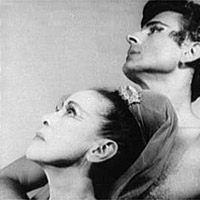 |

美國音樂與舞蹈在瑪莎‧葛藍姆與科普蘭合作後,合而為一。圖中的舞者是柏川‧羅斯
(Bertram Ross)

|
 |
|
 |
作曲家阿隆‧科普蘭 (Aaron
Copland) 出生在紐約布魯克林區
1900年11月14日
科普蘭對趨勢的敏銳度相當高,他也經常嘗試創作爵士的節奏與新風格。他知道收音機、留聲機,以及電影都創造出欣賞現代音樂的新聽眾。科普蘭於是以簡單的音樂來表達美國人的生活經驗,並把這些音樂譜為配樂。在這些配樂中比較重要的是根據美國民間故事所編譜的三曲芭蕾:比利小子 (Billy
the Kid,1938) 、羅迪歐 (Rodeo,1942) ,以及阿帕拉契之春 (Appalachian
Spring,1944) 等。這些曲子都得到舞者瑪莎‧葛藍姆的共同合作。當科普蘭與葛藍姆一起合作製作芭蕾舞劇的時候,葛藍姆曾寫信給科普蘭,她說:「我已經開始做你的音樂了。你寫得真是太好了。我已經迷上你的音樂了。」國會圖書館後來委託贊助這項作品的完成,而這個作品也首度登台表演。
Copland was very aware of the trends of his time, experimenting with jazz rhythms and new forms. He realized that radio, phonographs, and film were creating a new audience for modern music. Copland created scores that simplified music and expressed the American experience. Most important of these were the three ballets based on American folk material: Billy the Kid (1938), Rodeo (1942), and Appalachian Spring (1944), which was choreographed and performed by dancer Martha Graham. While Copland and Graham were collaborating on the creation of the ballet, she wrote to him, saying, "I have been working on your music. It is so beautiful and so wonderfully made. I have become obsessed by it." The Library of Congress commissioned the work where it was also performed for the first time.

 3/4 頁
3/4 頁

|





